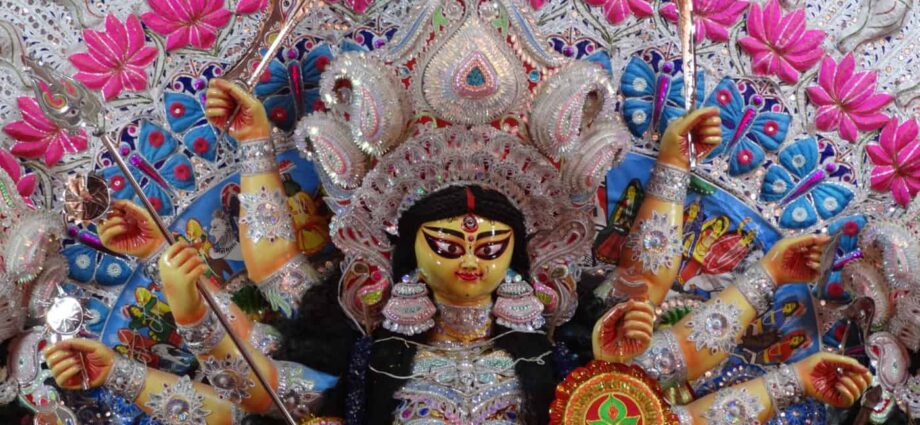While Eastern India celebrates Durga Puja, Ramlila is more prominent in the North during Navratri
When I came to Delhi, one thing that struck me was the prominence of Ramlila during Navratri/Durga Puja. It was not so in my town Deoghar, which falls in the eastern part of India. My village used to stage plays, but not Ramlila during Durga Puja. Navratri is celebrated in the North (Delhi, UP, etc.) more as the victory of Ram over Ravan than as the victory of Durga over Mahishasur, as in the east, though Durga remains the central deity of worship in both the places.
In Eastern India, especially places that once were part of the Bengal Presidency (Bihar, Orissa, Assam, Jharkhand, etc.), Durga Puja starts formally on Mahalaya with Birendra Krishna Bhadra’s Mahalaya recital, broadcast from AIR Calcutta and relayed by other radio stations. What used to be the worship of statues of the deity cast in stone and kept in Durga Mandaps in a smaller scale before the Bengal Renaissance gradually evolved into the worship of Durga Pratima cast in clay every year for Durgotsav or Sharadotsav, during the British rule. It was somewhat like the way Ganpati Mahotsav started in Maharashtra around the same period to awaken a sense of nationalism among people. Durgotsav held in Durga Baris saw participation by one and all, especially women.
Prominent Bengalis, including doctors, professors and businessmen, from all castes, were the main organisers of Sharadotsav in Durga Baris, unlike yesteryears when priests held sway. For the first time, the Deity came out of the temple to a Pandal to be worshipped in a clay form. Not only was it the worship of Shakti in the feminine form, but also an occasion to jettison the outworn shibboleths of the past that had put restrictions on women. Women were at the centre stage of celebration, breaking many social taboos. Major newspapers and magazines of Bengal would bring out their special editions dedicated to Durga Puja (Sharadiya Visheshank), which focused on writings that underscored social reforms, especially concerning women.
On the other hand, the centrality of Ramlila to Navratri in the North is perhaps attributable to the influence “The Ramacharitmanas” of Tulsidas enjoys among North Indians. The phraseology of day-to-day conversation in Hindi testifies to this Epic’s hold on the North Indian mind. Most of the significant locales of this Epic also lie in present day UP.
An epic is the tale of a nation, and a hoary nation, like India, as it grows over the centuries, undergoes changes in its demographic composition. Any rendering of an epic in a popular form like folk theatre has to take cognizance of the changes that the society undergoes.
Dr Anuradha Kapur, in a guest lecture at JNU, once told us how Ramlila began as folk theatre during Akbar’s period in Delhi and Uttar Pradesh. Started by Megha Bhagat in Varanasi, a follower of Tulsidas, Ramlila initially focused on ‘Ram Bharat Milap’ scenes. The war of succession that ensued among Mughal princes after the death of Mughal emperors found an echo in the Ramlilas staged by Purabiya soldiers of the Mughal army. Purabiya soldiers continued to stage Ramlila even after they joined Company Bahadur’s army (East India Company). The use of archery and gunpowder to burn Ravan’s effigy was their contribution to this folk form of the epic. Ramlila flourished in Awadh under the patronage of its Nawabs. Ramlila in Ramnagar as the locus classicus of this theatre form continues to draw international attention, with erstwhile Kashi Naresh still taking part in it.
Our theatre and dance forms, including Ramlila, derive their life force from ‘The Nāṭya Śāstra’ of Bharata who enjoys paterfamilias status among Indian literary thinkers. ‘The Nāṭya Śāstra’ was created as ‘Pancham Veda’ or the Fifth Veda, accessible to all without any prejudice of class or colour, unlike the other four Vedas. Ramlila, based on such noble principles of dramaturgy, shed various prejudices, which were not in keeping with the changed time. Many controversial parts of the Epic were not enacted. Moreover, when a sacred epic assumes a popular form like folk theatre, its text gets liberated from the sanctimonious hold of the clergy. The outcome is what Mikhail Bakhtin would call Carnivalesque. True to the spirit of ‘The Nāṭya Śāstra’ and the folk genre, Ramlila drew participation from one and all. The musicians were invariably Muslims. As an aside, it’s to be noted here that Indian classical music has been mostly preserved by Muslims only. It’s the catholicity of the Indian tradition that we see an Ali Akbar Khan rendering Raga Bhairavi with so much of devotion, and a Rahi Masoom Reza creating such a popular TV iteration of the Mahabharata.
Let’s burn the Ravan within, on this Navratri, and usher in the Ram Rajya that our Nation Builders envisaged.

